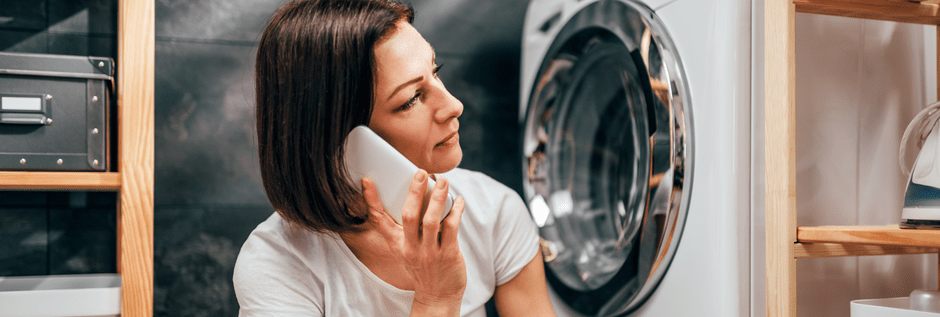Dryer not drying? Try these quick fixes to get your dry on.
Before giving up on your dryer, try these tips for prevention and repair.

Key tips to remember
- Never overload your dryer
- Dry clothes according to recommended settings
- Clean vents and ducts regularly
- Clean the filter before and after every use
- Be ready with tools for a little DIY maintenance
Is your dryer not heating? While it’s not the end of the world, a clothes dryer not heating is an irritating inconvenience that everyone must deal with at some point. Is your dryer not drying well? Is your dryer not getting hot? Are your clothes coming out of the dryer wet? Is your dryer not spinning? Is the dryer not spinning but heating? All these malfunctions are telltale signs of what is likely a simple problem you can fix at home. Before you call in the professionals or start searching online for “how does a dryer work,” take a few minutes to read our suggestions on what causes a dryer to stop heating, along with some common dryer troubleshooting and what you can do about it before considering investments in a major repair or replacement.
Plug it in
Yep, just like when you call tech support or the IT department, we must ask whether your dryer is plugged in or not. While we have no doubt you’re not one of those people who would make such a silly mistake, dear reader, you’d be surprised how often this is the culprit for all sorts of supposedly malfunctioning devices. If your dryer is plugged in but still seems dead, check your circuit breaker and reset it if it has been tripped. Typically, dryers run on two circuits, one for the unit itself and one for the heating element, so check both. Remember, an electric dryer runs on a 240-volt power supply, not the typical 120-volt outlet.
Don’t overload it
Whenever loading your dryer, if you want to avoid overloading it — one of the most common causes of problems preventing your laundry from getting dry — just remember the rule of three: Three-quarters full is plenty. Always leave at least a fourth of the space in the dryer open for airflow. Without it, your dryer is going to be overworked and ineffective. A dryer heats up the water in wet clothes, which turns into steam before being vented from the unit. If you’ve taken up all the space in your dryer with the clothes, you’re not leaving any room to allow the steam to escape, and you can expect problems.
Check settings
In case you weren’t aware, most clothes and bedding come with labels that indicate what sort of dryer settings you should use to dry them. Many even include symbols that point you to the correct settings on the machine. If you never pay attention to what settings you’re using on the dryer, you’re probably doing it wrong. For example, a load full of towels and jeans needs a heavy-duty cycle, but a lighter cycle will be more appropriate for washing T-shirts and dish towels. To optimize your dryer’s performance, take a closer look at what you’re drying and what is recommended. While you’re at it, read the dryer’s user manual for tips.
Check vents and ducts
Remember what we mentioned about airflow? Here’s where it can get tricky. Just as you need adequate airflow within the dryer itself, your vents and ductwork also need to be free from obstructions so that your dryer can effectively vent the moist air steaming away from the clothes as they dry. Lint from clothes tends to build up over time and can cause blockages and even a fire hazard. It’s a good idea to clean the ducts and vents (including where the duct meets the dryer and where it meets the outside vent) at least every couple of years. You can easily clean inside the length of a duct with an attachment on a vacuum cleaner.
Seal vent joints
While you’re already cleaning your dryer vents and ducts, it’s a good idea to seal the vent joints with heat-resistant aluminum tape. Attempting this same fix with regular duct tape can result in a sticky mess. Duct tape melts with heat, attracts lint, and is likely to cause more clogs, also a common problem with foil or plastic dryer ducts. If you need to replace an older duct that’s made of these materials or is otherwise in bad shape, be sure to get the U.S. Consumer Product Safety Commission’s recommended type: a semi-rigid aluminum duct.
Clean the lint filter
Before you conclude your mission of cleaning ducts and vents and sealing joints, don’t forget what might be the most obvious location in need of your attention: the lint filter. If you’re not already in the habit of cleaning out the lint filter before and after every load, it’s high time you started. It’s a simple fix that takes seconds and can save you all sorts of headaches, from your clothes not getting dry to preventing a fire, which happens more often than you might expect. In addition to cleaning out the filter with a quick swipe of your hand before and after every load, get into the habit of taking out the filter and scrubbing it with a stiff brush in hot and soapy water. Let it dry out thoroughly prior to reinserting it into the dryer, and so this at least once every couple of years. To help remember, schedule this deep cleaning of your lint filter to coincide with that biannual vent cleaning you were planning.
Check the door switch
Here’s one on the less-obvious end of the spectrum, something that may not have occurred to you. All dryers have switches designed to prevent them from functioning when the door is open. If your machine is still refusing to run, investigate the door switch located inside the seam around the door itself. If the machine won’t run with the door shut, try opening the door, finding the door switch, depressing it with your finger, and then trying to power on for a cycle. If this works, try adjusting the door on its hinges to better ensure the door switch fully depresses when the door shuts. If this isn’t possible, you may need a new door switch or possibly a new door.
Check the drive belt
Part of the essential motion of a dryer involves turning the bin of clothes over and over to extract the hot steam as the fabrics warm. A drive belt that spins the bin (or drum) holding the clothes creates this motion. Like any drive belt, this one can wear out, loosen or break over time. If your dryer powers on but doesn’t spin, you may need to replace the drive belt. This fix typically requires removing the top and front panels so you can access, remove and replace the old belt with a new one.
Check the heating element
If you’re still wondering “why is my dryer not getting hot,” your answer could be a bad heating element. If your dryer is electric, the heating element is a small electric device that’s inexpensive to replace, usually with only a screwdriver. However, it does require taking apart the dryer to access the heating element to make sure it’s clean and separate from other components. You then need to test it with a voltage meter, and ultimately remove and replace it before reassembling the dryer if the heating element no longer functions. While you’re in there, check to make sure the thermal fuse hasn’t blown. Gas dryers, on the other hand, use gas burners to heat the air and do not use a heating element. If you’re dealing with a gas dryer, make sure it’s connected to the gas and the shutoff valves are open both inside the home and at the street level.
Check the blower wheel and drive belt
The blower wheel sucks in air from outside the dryer, heats it using the heating element, and then blows the hot air through the bin (or drum) tossing the clothes around. If you notice any weird rattling or vibrations, you might have a blower wheel problem. After unplugging the unit, remove the dryer’s back panel. Look for any problems with the blower wheel. If you conclude that it’s blocked, damaged or needs to be replaced for any reason, remove the remaining panels of the dryer. Next, remove the drum from the drum bearing for access to the motor, from which you should be able to unscrew the blower wheel for replacement.
Replace the motor
Without a motor, your dryer’s blower wheel can’t turn. If the blower wheel doesn’t turn, air won’t flow, the bin (or drum) won’t spin, and you’re stuck with a useless dryer that might still heat up but won’t accomplish much else. If you’re getting power and feeling heat, but there’s no spin and no heated air blowing, it may be time for a new dryer motor. This can be done at home but will require taking the dryer apart, reading the manual so you buy the correct motor model, and checking the possible need for additional parts.
Replace the control panel
If your control panel isn’t responsive, but you’re sure the unit is getting power, it may be time to replace the entire control panel. Owner’s manuals typically give you the precise part number for a replacement control panel, along with instructions on how to install it with a few sockets or screwdrivers. Depending on the model, you might replace only certain parts of the panel, allowing you to keep using the rest of its functions.
Call in a pro
Most dryers last around 15 years, more or less. With this life span in mind, if you’ve tried all these suggestions and still have issues with your dryer not drying, it may be time to call in a professional or have the unit replaced.
Thanks for stopping by for our post on troubleshooting a dryer that’s on the fritz. If you’d like to read more about how to clean and maintain your dryer, you’re in the right place. We also have ideas about what to do when your dryer won’t spin and insights into whether a home warranty covers your washer and dryer. We have these and many more posts on appliances and all sorts of home improvements here for your perusal. Thanks for stopping by!
The information in this article is intended to provide guidance on the proper maintenance and care of systems and appliances in the home. Not all of the topics mentioned are covered by our home warranty or maintenance plans. Please review your home warranty contract carefully to understand your coverage.



